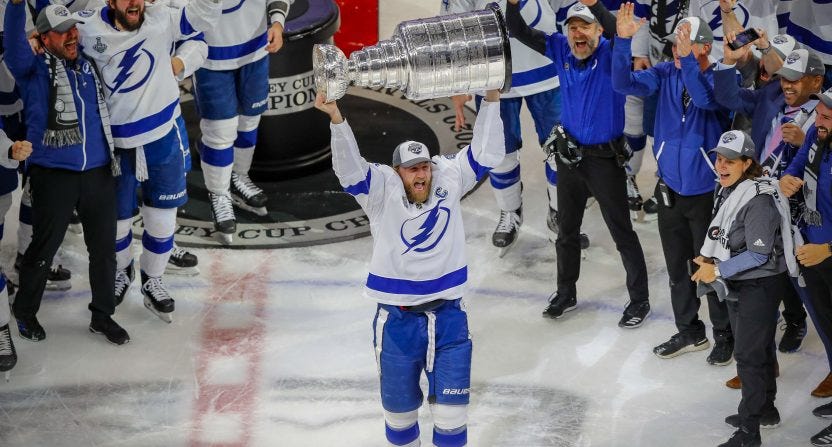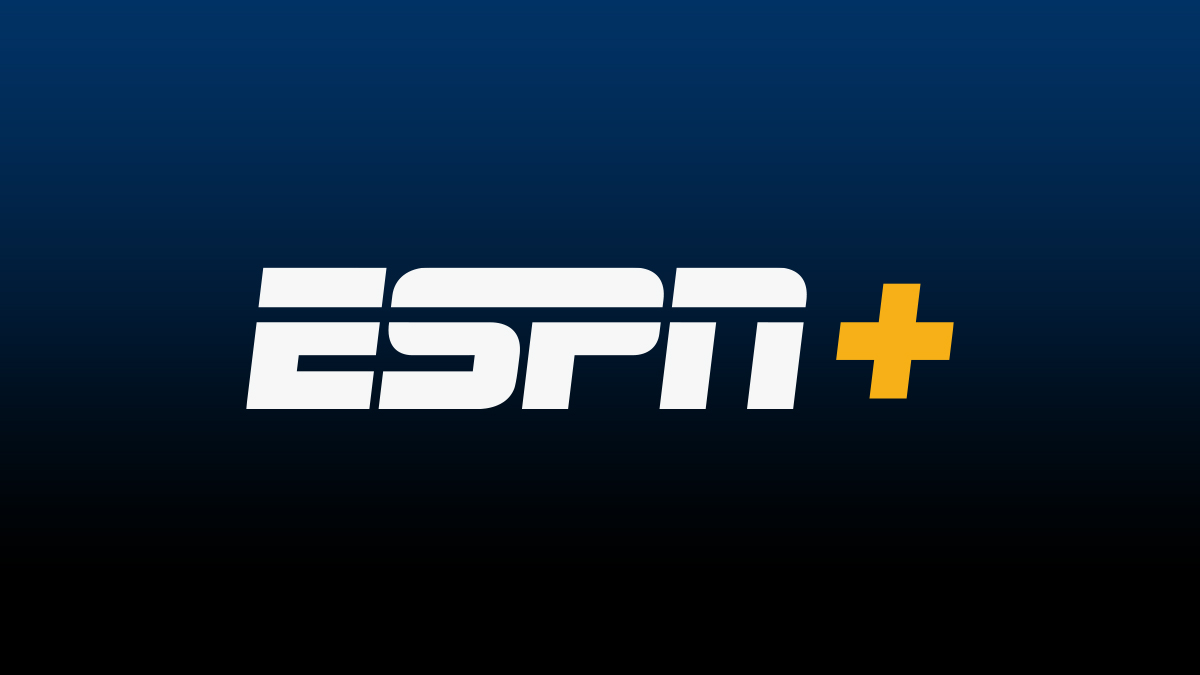If Bob Chapek is to be believed, the center of Disney’s sports bets is ESPN+ — a streaming service that up until 2020 existed as more or less ESPN Minus. ESPN+ existed, seemingly, to answer, “What if you wanted sports, but none of the good ones?”
Now, however, ESPN+ is the future of Disney’s sports bet. Except it’s not. Not really.
Let’s get caught up to speed. Two important things happened this week. Disney CEO Bob Chapek spoke at Goldman Sachs conference about a plethora of things, including ESPN’s future, and Disney signed a new deal with the NHL that will bring more than 1,000 games to the company’s streaming service. Both are related. Chapek told a virtual audience at Goldman Sachs’ conference that Disney “won’t contemplate rights deals going forward that don’t envision ESPN+ being a major player in those rights content.”
“Whenever we get into any kind of rights negotiations, we're making sure ESPN+ is going to be a really big part of that,” Chapek added.
A few days later, the NHL deal was announced. On a call after the deal, Chapek alongside ESPN head Jimmy Pitaro, and NHL commissioner Gary Bettman spoke about the move, which marks the first time Disney will have NHL games since 2004. The deal will run for seven years. It’s a changing landscape within sports media right now, as Bettman pointed out, and at the forefront of that change is streaming. Or, more specifically, cord cutting. It’s a change that Pitaro told reporters is “at the heart of this deal,” according to Variety’s Brian Steinberg.
“This is a reflection of its role as a critical part of our future,” Pitaro said, adding that it will make ESPN+ a must-have for NHL fans.
Someone roars, Bobby scores
What does that actually mean? Here’s a breakdown from Chaim Gartenberg at The Verge:
ESPN Plus is effectively replacing NHL.TV as the NHL’s out-of-market streaming service, with over 1,000 games each season available for fans to stream. ESPN and ABC will also get 25 exclusive national regular-season games each season, while 75 games a year will be exclusive to ESPN Plus and Hulu.
The most important parts of this story — of Disney’s ESPN+ plans — are in that paragraph. We can break it down into four distinct questions:
Why is this happening with the NHL and not the NFL, which Disney reportedly agreed to pay $2.6 billion to in order for Monday Night Football games that will appear on ESPN and ABC but not ESPN+?
How does the Hulu incorporation play into other Hulu and ESPN announcements made this week?
Bettman reportedly wanted to split the rights between several media organizations to maximize potential revenue. Smart. So, why didn’t that happen?
How does this help NHL fans?
The answer to the first question is obvious: viewership.
Let’s do the unthinkable and leave 2020 out of this scenario. It’s not fair to judge leagues based on a year where nothing made sense. Instead, let’s look at years before that. In late 2018, as part of a forecast looking at 2019, Activate reported that the most watched sport in the United States was the NFL with the average number of viewers per season hovering around 137 million. In second was MLB (83 million), with digital esports (63 million) and the NBA tying for third (63 million). The NHL was in fourth, bringing in an average of 32 million viewers.
Bluntly, the NHL is not the NFL. This gives the NHL slightly less bargaining power, and Disney just a smidge more bargaining power. Disney agreed to pay the NHL roughly $400 million a year for the rights, according to the New York Times, double what NBC paid the league between 2011 and 2020. ESPN has twice the reach of NBCSN, where many NHL games streamed, and with access to streaming, the belief from analysts is that the NHL’s viewership will grow.
A few things have changed since NBC signed its deal with the NHL. Most notably, cable cutting between 2011 and 2021 has grown exponentially. ESPN has bled subscribers, and Disney executives are trying to think of how to recapture some of that audience while transitioning others to a digital and streaming-first product.
Viewership for Stanley Cup games, which Disney’s ESPN and ABC will now have ownership of over the next four years, increased slightly between 2015 and 2019. Plus, the NHL has seen steady valuation growth between 2015 and 2020. (Well, up until 2020, that is). It’s the game that attracts the most in-person attendance at games on average.
NHL viewership has its ups and downs throughout the season, but there’s the potential to grow an audience by leaning into a more accessible and cost effective digital route. ESPN+ needs more subscribers. Plus, ESPN+ costs substantially less than NHL.TV, which allows hockey fans to watch out of market streaming games. NHL.TV costs $150 a year, while ESPN+ is just $60. That’s 40% of NHL.TV’s cost, which might also incentive more people who like hockey to watch a bunch of NHL games at a discounted rate. (This is the answer to the fourth question.)
“Stepping back, we see this deal as a continued evolution of the sports rights model,” analyst Michael Nathanson wrote in a note. “It is our belief that the linear bundle will still be home to marquee sports events like the NFL regular season, NFL Playoffs, MLB Playoffs, NBA Playoffs, NHL playoffs and golf’s majors.
“With that said, more niche sports and events like the WWE, EPL and regular seasons of lesser sports will likely migrate to DTC platforms like ESPN+, Peacock and Paramount+.”
Will making watching the NHL easier for a younger generation bring in more fans? A 2017 study from the Sports Business Journal found that the NHL had one of the oldest viewing audiences in 2016, averaging out at 49. That’s a sharp increase from 16 years prior when the average age of the NHL’s viewing audience was 33. As Vice reported in 2017, the “NHL’s insular attitude is killing it.”
The NHL isn’t the only league seeing an increase in average viewership ages as younger demographics continue to get rid of cable, but the NHL hasn’t embraced the digital future as much as the NBA, which does tout a younger viewing audience. From the NHL’s perspective, having a number of its games available on a platform that is cheaper to afford and, more importantly, part of a bundle customers may already have or are likely to sign up for, is an optimistic bet.
And this, in my opinion, is Disney’s big bet. It’s not ESPN+, it’s the bundle. As part of the new deal, Disney will simulcast 75 of the games on Hulu – a win for the NHL and for the House of Mouse. Hulu has a much bigger subscriber base (~40 million) compared to ESPN+ (12.1 million), and also represents a potentially different audience than diehard sports fans signing up for ESPN+ to watch UFC or other things. Hulu offering NHL games could be great for the casual subscriber, reminding them of this whole other streaming service.
After Disney announced the bundle in 2019, Apptopia found that downloads for ESPN+ and Hulu grew by 50%. Since the bundle’s release, the subscriber base for Hulu and ESPN+ has grown exponentially, with ESPN+ adding more than six million subscribers between December 2019 and December 2020, and Hulu adding about 9 million subscribers within the same period. So much of that ESPN+ growth arrived at a time when there were no real sports events happening, leading many analysts to believe growth was largely due to the overall bundle.
Disney executives aren’t trying to hide their plans to turn their streaming offerings into one integrated universe. Chapek announced this week that ESPN+ programming will be available to access directly within Hulu. Subscribers will also be able to buy UFC PPV fights directly via Hulu beginning this summer so long as they’re also ESPN+ customers. Having things on Hulu might be easier for customers (the UI is better than ESPN+) and it encourages people to never leave the app, but they’re still paying for ESPN+. With roughly 60% of Hulu subscribers also self-reported sports fans, according to the company, the synergy makes sense.
But Disney also has bigger ESPN direct-to-consumer ambitions. Executives are trying to figure out what will grow its subscription business and drive more digital ads, while also taking in substantial amounts of revenue via its traditional cable business. Getting rid of niche sports like X-Games and signing rights deals for major sports like the NHL is one way to do just that. Bringing the games into Hulu, where there’s a popular ad-supported tier, and adding increased overall watch time on the service, will help Disney sell better, targeted ads at a higher rate. Well, hopefully.
It also needs to be stated: ESPN+ isn’t a replacement for ESPN. The cable network is losing subscribers but it still generates sizable revenue for Disney. ESPN+ is at the center of catching falling cord cutters, promoting more bundle sales and, I would wager, decreasing churn.
Not to mention that subscriber growth always makes analysts happy. Even if people aren’t actually spending more time watching said streaming services, those numbers on a spreadsheet are increasing. Think of it this way: ESPN+ has doubled its subscriber base, but has it doubled the amount of time spent on the app? Are new bundle signups actually watching just as much ESPN+ as Hulu or Disney+?
With the NHL deal, the goal is that a larger percentage of people will sign up for ESPN+ to watch games, but the Hulu integration is a bet that Disney can keep people in one ecosystem. The NHL might give Disney — and other sports leagues — the boost in numbers to convince other leagues to try something similar.
Well, maybe not the NFL anytime soon. Disney’s recent deal proves that the NFL isn’t ready to shift all of its Monday games to ESPN+, and Disney also doesn’t want to lose a core ESPN cable subscriber driver. It’s a “pivot to streaming,” but with one foot still firmly planted in traditional cable business. But if everything works out the way Disney and the NHL hope — an increase in younger viewers, an increase in subscriber growth, an increase in interest for the NHL again — does that mean there could be a future where top NBA games or MLB games also stream on ESPN+?
“It's not a mandate to us that we get these rights,” Chapek told Goldman Sachs audience, “but if they deliver economic value, we'd love to remain in business with us. We'll approach it with discipline, and once again, ESPN+ will be a critical component to any deal we make in the future.”
Correction: A previous version of this stated average views per game. It is in fact average views per season. Changes have been made in the post. I regret the error!







This hockey fan is very excited by this move!